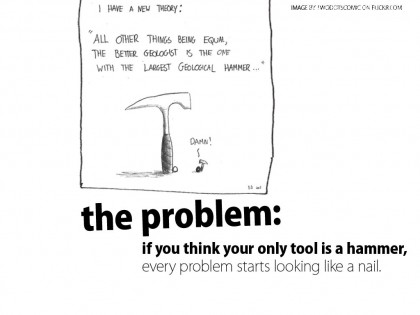If an identity is to create value through identifiable and differentiating qualities, it can’t be designed through employment in the latter stages of a standardized process
. It needs to lead the entire creative and strategic process from its initial spark to its finale.
In his talk on FMCG, brands and product design, Richard Murray suggests that we are better at creating categories than individual brands
.
Is the sameness of unoriginal ideas to be blamed on our processes being too similar? If the analysis to the insight, to the design and form follows the same pattern across consultancies, agencies and brands, then everybody follows a similar pattern in order to discover the great insight that leads to the unique idea. The problem is, there is a lack of unique ideas. We are in a hammer and nail situation: “If we think our only tool is a hammer then every problem looks like a nail”.

Organic platforms isn’t only evidence of this, it might as well be the biggest category driven collection of surfaces we have
.
A great deal of organic productions are built on an offspring of a model created back in 2000. A brilliant tool with an unfortunate side effect: everybody follows an identical pattern for development, one that engineers the structure in a one-dimensional approach, before adding identity at the end; as some kind of tag.
There are originally two legs to identity: The first one is the understanding that the visual identity and story of the product helps it differentiate itself in the market and create a place in peoples harts. The second one is the experience created around the product which helps the product become unique, by enhancing its identity through experience
.
On organic platforms there is a third leg as well: Identity design is not only used to design experiences, it also identifies existing experiences.
What does this mean: Designing identities, on organic platforms, has expanded it’s traditional form, which to a large extent has been focused on visual identities and story. Designing identities now also demands that we identifying existing experiences and redesign / augment / ad value to them.
The result of the existing generic standardization, is that it has created an overwhelming range of sameness. Different brands offering the same services, content and applications online – following a pattern that not only creates a surge to make sure we are offering whatever everybody else is offering (the artificial standard / benchmark), but worse – having everything created, copyable by the competition
excluding age & genderand intervention may be appropriate. What is sildenafil?.
.
Adding a different color scheme or logic at the end of a process does not create a unique experience, it merely ads a label to a generic offering. This is the result of a mindset where identity takes a back seat and is added at the end.
A generic brand identity is not an identity, its a category
.
Unique and identifiable brands on organic platforms comes from doing the opposite to the standard process: It starts with the identity, and employs it to every strategic and creative decision from the first spark to the finale. Resulting in a unique and identifiable experience, which the competition is unable to copy and standardize in the marketplace.


Helge,
I think we spend too much time designing the identity of our products and brands and think too little about how these things will allow people to create their identity through those artifacts.
Only until a product can help us define our identity among our peers will it be successful in a networked age.
Hi Bud
An interesting response, and one I’m contemplating a lot myself at the moment. In my mind the argument is valid, but at the same time limits the perspective of our process as it invites us to accept that there is a universal principle to everything (everything we do is related to how we want to be identified within the group of our peers), which kind of proves my point.
If we give people the credit for being multifaceted, in the extent of that everything they do has something to do with a range of stuff, and that the mix and weighting of influential arguments is different from category, situation, individual and not least; irrationality. Then the incentive for acquiring stuff or joining something will be a range of different things, some of them are connected with other people, some of them are individual and some of them are practical or even rational.
In my mind we need to embrace variability and find which powers are more, or less, powerful in each individual case. Sometimes that will be the dream of enjoying an Italian cuisine, and sometimes it will be positioning oneself as the more sophisticated connoisseur of whiskey in a group, the one with the most delicate palette and understanding of quality – as example.
Now agencies often find their ideology, which to a large extent can prove right, making them experts and the perfect fit for companies and products that need this specific ideology. But, first; there is a long way from this to suggesting universal principles, and secondly; it also limits the perspective and sends us in search for nails instead of scissors or even potatoes.
Thanks for having me mull this one over, as you see I’m a strong believer in variability and the complexity of the human mind.
Best
Helge